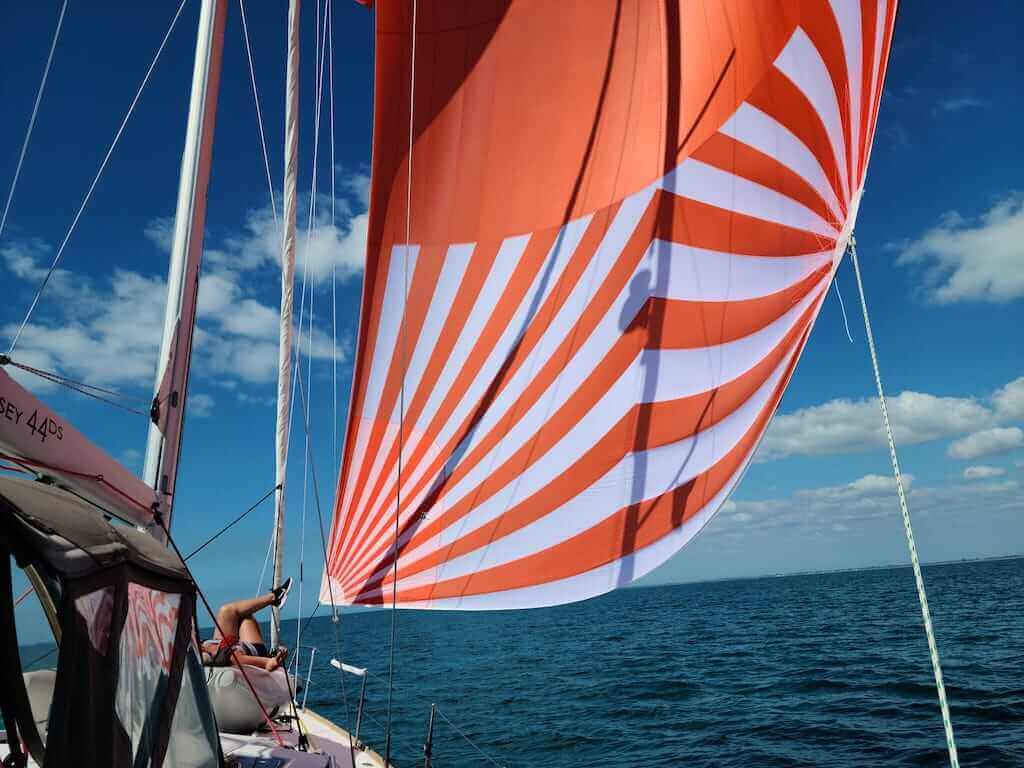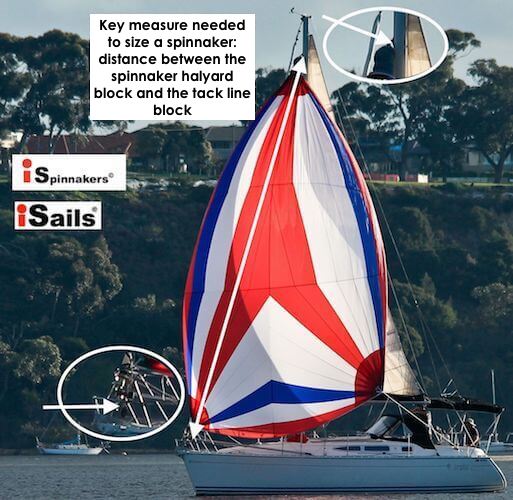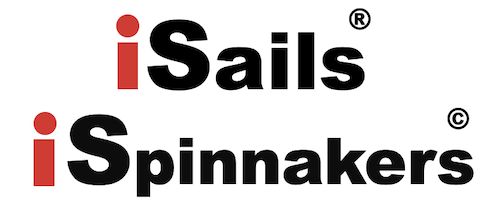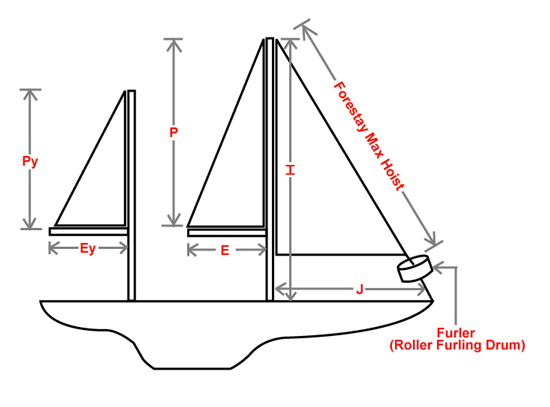
You may be wondering « what size of asymmetrical spinnaker or symmetrical spinnaker do I need for my boat?” Or “can you tell me the dimensions of the cruising spinnaker I need based on my boat length or boat model?” Or “ is the area different if I choose an asymmetrical spinnaker or a symmetrical spinnaker? ».
Even if you still have some summary spec sheet for your boat, it may only indicate an approximate spinnaker square footage, but not the specifics of the luff, leech, or foot for the spinnaker you need. Also the size information provided may not be adequate if you use a spinnaker sock or a furler, or if you have a sprit. And finally, older boats manuals often recommend spinnakers too small, as the technology has really evolved.
Finally, as background, you should know that spinnakers are not as “finicky” as flat sails for the purpose of fitting a particular boat (flat sails would be a main sail, a genoa or a jib); for spinnakers, there is often room for variations without any measurable negative consequence on sailing performance. This true for asymmetrical spinnakers or symmetrical spinnakers alike.
Hence a range of standard sizes covers most boats, which minimizes the cost of the spinnaker.
So let’s start:
- Symmetrical spinnakers sizing
- Asymmetrical spinnaker sizing
- How to measure max hoist if you have access to the boat
- If you do not have access to the boat: Starter tool by boat brand
- If you do not have access to the boat: Estimate the max hoist via the forestay length with the I and J
- If you are using a sock / furler, or have a sprit…
- For a custom or racing spinnaker
- Contact us for spinnaker sizing advice
1. Symmetrical spinnaker sizing
It is fairly easy to figure out how to size a symmetrical spinnaker. Specifically, the leech / luff length of a symmetrical spinnaker should be about the same length as the I of the boat and no smaller than 95% of the I.
As far as a pole is concerned, it is recommended that the pole be the J length.
These dimensions I and J are standard measurements usually published in the owner’s manual. You can also consult sailboatdata.com which is an excellent source for boat data.
Can’t find it? Contact us using the form at the bottom of this page so we can work with you.
Once you have the I of your boat, consult the symmetrical spinnaker dimensions page to see what standard symmetrical size you would need in our range.
If you fall in between, we can easily adapt, so contact us.
Basically:
- I is measured along the front of mast from the halyard to the main deck. The main deck is where the deck would be if there were no deckhouse.
2. Asymmetrical spinnaker sizing
For an asymmetrical spinnaker, the goal is to have the right luff length. The luff of a spinnaker sized right will assume the intended curve while the sail is fully hoisted, with the tack reasonably close to the deck. If the spinnaker is too small, you will have to trim the luff too tight, or let the tack fly too high. If the spinnaker is too large / long in the luff, you will not be able to trim it right for reaching / tight reaching.
However, you cannot measure a luff length directly. To figure out the right luff length, we derive it from the space available to install a spinnaker as measured from the halyard block (technically the bearing surface of the tackle) down to the tack attachment point, (technically again, the bearing surface of the tack line shackle).
We call this distance the “Tack To Head”, or TTH, also called “max hoist”.
TTH / max hoist is different than the luff, see below picture. We then use a conversion table to deduct what size spinnaker is needed (luff, leech, foot, area).

2.1. How to measure for an asymmetric If you have access to the boat
If you have access to the boat, and to measure max hoist, just hoist a measuring tape on your spinnaker halyard; and measure down to the point where you will attach the block for the tack line of the spinnaker.
If you do not have a tape long enough that you could hoist and measure directly, just hoist a non-stretch rope on the spinnaker halyard, and mark it with the tack position. Then take the rope down and measure the rope on the ground between the end that was attached to the halyard and the point you marked.
* Here is a little tip: if you measure with a tape, attach a thin line to the spinnaker halyard along with the tape: if the tape should break, the line will let you bring the halyard back down without having to climb the mast to get the halyard back….

Then simply plug it in our size table and find an estimate of the standard spinnaker size that could fit your boat. Access the table here (opens in a new tab). Please note that the conversion table will be specific to each sailmaker.
Deciding on the dimensions and size of your cruising spinnaker can also be specific to your navigation circumstances or preferences, if your mast has been updated, if you have sprit, will use a sock or a furler, etc.
2.2. Starter tool by boat brand for an asymmetrical spinnaker
If you do not have access to the boat and would like a first estimate, you can use our starter tool.
Navigate to the find your boat page, or use the main menu to get to your specific brand / shipyard.
Once you find your boat model, the table provides a first estimate of the spinnaker size recommended in our standard cut spinnaker range. Then follow the link to the detailed dimensions page, or to the spinnaker store.
Just know that we will always check these with you before placing your order with the factory.
2.3. estimate the forestay length with the I and J
If you do not have access to the boat, you can figure out the space available as measured from the halyard block (technically the bearing surface of the tackle) down to the tack attachment point, (technically again, the bearing surface of the tack line shackle) by using the I and J of your boat and the Pythagoras formula.
Please note that I (or ISP) and J are very specific to your boat model and its rig.
This approach will work as long as you set it on the bow (not on a sprit) and your foretriangle has somewhat standard proportions (ie for most boats of recent design). If you plan on using a sprit or have special equipment, then you will be better off measuring on your boat. (see point 4 below on this page).
We do have the I and J information for many boats so contact us first. A good database can also be found on sailboatdata.com. You will usually find the I and the J in the detailed specs in your owner’s manual as well.
Then use the formula below (sailboatdata.com gives you this number for many boats)
- Estimated forestay length = √(I2+J2) (read square root of (I square + J square)). (Thanks Pythagoras!)
Once you have the correct estimated forestay length, check our conversion table and find which size will fit your boat in our standard spinnaker size range. Access the table here (opens in separate tab)
Please note that the conversion table will be specific to each sail maker.
Basically:
- I is measured along the front of mast from the halyard to the main deck. The main deck is where the deck would be if there were no deckhouse.
- J is the base of the fore triangle measured along the deck from the tack line attachment block to the front of the mast.
- Then use the formula:
- Estimated forestay length = √I2+J2 (read square root of (I square + J square)). (Thanks Pythagoras!)
2.4. Sizing a spinnaker when using a spinnaker sleeve, a furler, or with a sprit
We said earlier that the important number is the length available between the spinnaker halyard when fully hoisted and the tack. If you use a spinnaker sock, a furler, or a sprit, these come into play in the calculation as there will be “less” or “more” space available to fit your spinnaker. Depending on your boat, you may need a smaller standard size or a custom size (usually for sprits).
A couple of things to keep in mind:
- if you are going to use a sock, the head of the sail will be shackled to the bottom of the sock built-in cable/swivel hardware, rather than to the halyard shackle – the length of this cable needs to be deducted from the forestay length. We can calculate this for you.
- if you are planning to use a top down furler, you need similarly to deduct from the estimated forestay length the length of the bottom and top fixtures to which the spinnaker will be mounted.
- if the spinnaker is set on a bow sprit, rather than at the bow, you need to add to the estimated forestay length, because you will need to be able to bring the tack tight down to the end of the bow sprit (you can not do that if the tack is at the bow, because this would cause too much wear and tear against the pulpit).
3. sizing a custom or racing spinnaker
For modified rigs, for modern catamaran masts set way back on the boat, for bowsprits, or for racing programs, we will likely design a custom spinnaker if necessary. We will need at minimum the I and J to design a custom size / shape spinnaker. Ideally, we will want to measure:
- how far are the spinnaker sheet lead blocks from the tack of the sail (for an asymmetric) ; or from the bow (for a symmetric)
- how far from the boat media axis are the sheet lead blocks
Use the contact form below for more information.





